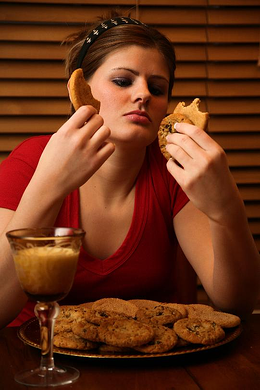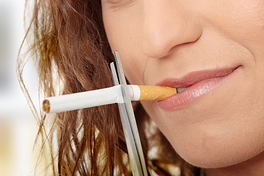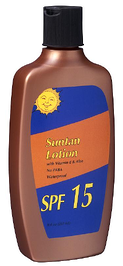This blog was written by Jenna Pearson. Meet our blogging fitness specialists at the NIFS website.
 In 2007, 11.7 million Americans were reported to have some form of invasive cancer. Men have a greater than 44 percent chance of developing some sort of cancer during their lifetime—this means that almost one out of every two males will be plagued by cancer. Furthermore, statistics show that more than 23 percent of men will end up dying from cancer (that’s nearly one out of every four). Women fare slightly better with a 38 percent chance of developing cancer (one in three) and a 19.6 percent chance of dying from cancer (one in five).
In 2007, 11.7 million Americans were reported to have some form of invasive cancer. Men have a greater than 44 percent chance of developing some sort of cancer during their lifetime—this means that almost one out of every two males will be plagued by cancer. Furthermore, statistics show that more than 23 percent of men will end up dying from cancer (that’s nearly one out of every four). Women fare slightly better with a 38 percent chance of developing cancer (one in three) and a 19.6 percent chance of dying from cancer (one in five).
October is National Breast Cancer Awareness Month. Why dedicate a whole month to breast cancer awareness? Of the more than 11.7 million cases of invasive cancer, about 2.6 million were breast cancer. More than 12 percent of all American women have breast cancer right now (that’s one out of every eight). Of those women, almost 3 percent will die from breast cancer (1 in 36). Early detection and awareness provide great defense against breast cancer. Health professionals estimate thousands of lives are saved each year through regular screenings and self breast exams.
Who Is at Risk for Breast Cancer?
Essentially, anyone with a pulse can develop breast cancer. Following are specific risk factors:
- Although men can be affected, being a woman is the main risk factor for developing breast cancer, as women are about 100 times more likely to have breast cancer than men.
- Age also plays a role in breast cancer development, with increasing age heightening your risk. About one out of every eight invasive cases occurs in women under the age of 45, whereas two out of three cases are found in women over 55.
- Five to ten percent of all cases are thought to be hereditary, or genetic, resulting from gene defects.
- Those with a positive family history of breast cancer are also at a higher risk (approximately three times more likely) than those having no immediate relatives affected by the disease.
Visit www.cancer.org to find out more about the risks for developing breast cancer.
Making Strides Against Breast Cancer
Support breast cancer fighters and survivors by participating in a “Making Strides Against Breast Cancer” event. Visit the American Cancer Society online to find an event near you.

 Habits are hard to break. This is especially true when it comes to your health. It’s very easy to fall into routines of not exercising, late-night snacking, eating out, watching several hours of television, and so on. In addition to diet and exercise-related health rituals, other behaviors that can be detrimental to health and similarly very hard to break free of include smoking, excessive alcohol consumption, excessive caffeine consumption, and self-loathing (or having a negative self-image)…and we all know how hard those can be to overcome!
Habits are hard to break. This is especially true when it comes to your health. It’s very easy to fall into routines of not exercising, late-night snacking, eating out, watching several hours of television, and so on. In addition to diet and exercise-related health rituals, other behaviors that can be detrimental to health and similarly very hard to break free of include smoking, excessive alcohol consumption, excessive caffeine consumption, and self-loathing (or having a negative self-image)…and we all know how hard those can be to overcome! With more and more studies indicating just how dangerous to health sitting at a desk can be, incorporating small bouts of physical activity throughout the workday is as important as ever.
With more and more studies indicating just how dangerous to health sitting at a desk can be, incorporating small bouts of physical activity throughout the workday is as important as ever. To fully understand the relationships that exist between positive emotions and food choices, researchers dissected the traits that classify personalities as happy and/or hopeful. They found that those with hopeful personality traits focus mainly on the future, while people with happy personalities tend to beam from past achievements. In looking toward the future, hopeful people choose more health-conscious snacks, and also exhibit greater levels of self-control than their happy, prideful counterparts who are simply “living for the moment.”
To fully understand the relationships that exist between positive emotions and food choices, researchers dissected the traits that classify personalities as happy and/or hopeful. They found that those with hopeful personality traits focus mainly on the future, while people with happy personalities tend to beam from past achievements. In looking toward the future, hopeful people choose more health-conscious snacks, and also exhibit greater levels of self-control than their happy, prideful counterparts who are simply “living for the moment.” We’re right in the heart of blueberry season, so it’s a great opportunity to look at what makes this delicious summertime favorite so nutritious.
We’re right in the heart of blueberry season, so it’s a great opportunity to look at what makes this delicious summertime favorite so nutritious. Take a second and think about the last time you read the instruction manual to anything. Does anyone take the time to actually read along in emergency guide on an airplane in case of an actual emergency? No, you just sit there and wait until you are allowed to turn back on your iPod, iPhone, computer, or whatever electronic device they made you turn off.
Take a second and think about the last time you read the instruction manual to anything. Does anyone take the time to actually read along in emergency guide on an airplane in case of an actual emergency? No, you just sit there and wait until you are allowed to turn back on your iPod, iPhone, computer, or whatever electronic device they made you turn off. s this year. These
s this year. These  the yard, and move in other fun ways to show them how much fun exercise can really be when you find something you like. Now is the time to ingrain the habit of regular physical activity in their life.
the yard, and move in other fun ways to show them how much fun exercise can really be when you find something you like. Now is the time to ingrain the habit of regular physical activity in their life. Let’s hope that if people are sitting at the beach all day they will think to use it, but there are many circumstances in which sunscreen should be used but just isn’t. I recently went on a several-hour car ride and although I do wear sunscreen on my face, my arm and shoulder were red from the sun coming through the sunroof!
Let’s hope that if people are sitting at the beach all day they will think to use it, but there are many circumstances in which sunscreen should be used but just isn’t. I recently went on a several-hour car ride and although I do wear sunscreen on my face, my arm and shoulder were red from the sun coming through the sunroof! We have been told for years to stay out of the sun because of its aging effect on our skin and bodies. Finally, there's a benefit to being out in the sun and eating lots of sushi! Sunshine and salmon are the two best sources of vitamin D. You may want to reconsider a little bit of sunshine to prevent some common diseases as people age.
We have been told for years to stay out of the sun because of its aging effect on our skin and bodies. Finally, there's a benefit to being out in the sun and eating lots of sushi! Sunshine and salmon are the two best sources of vitamin D. You may want to reconsider a little bit of sunshine to prevent some common diseases as people age.